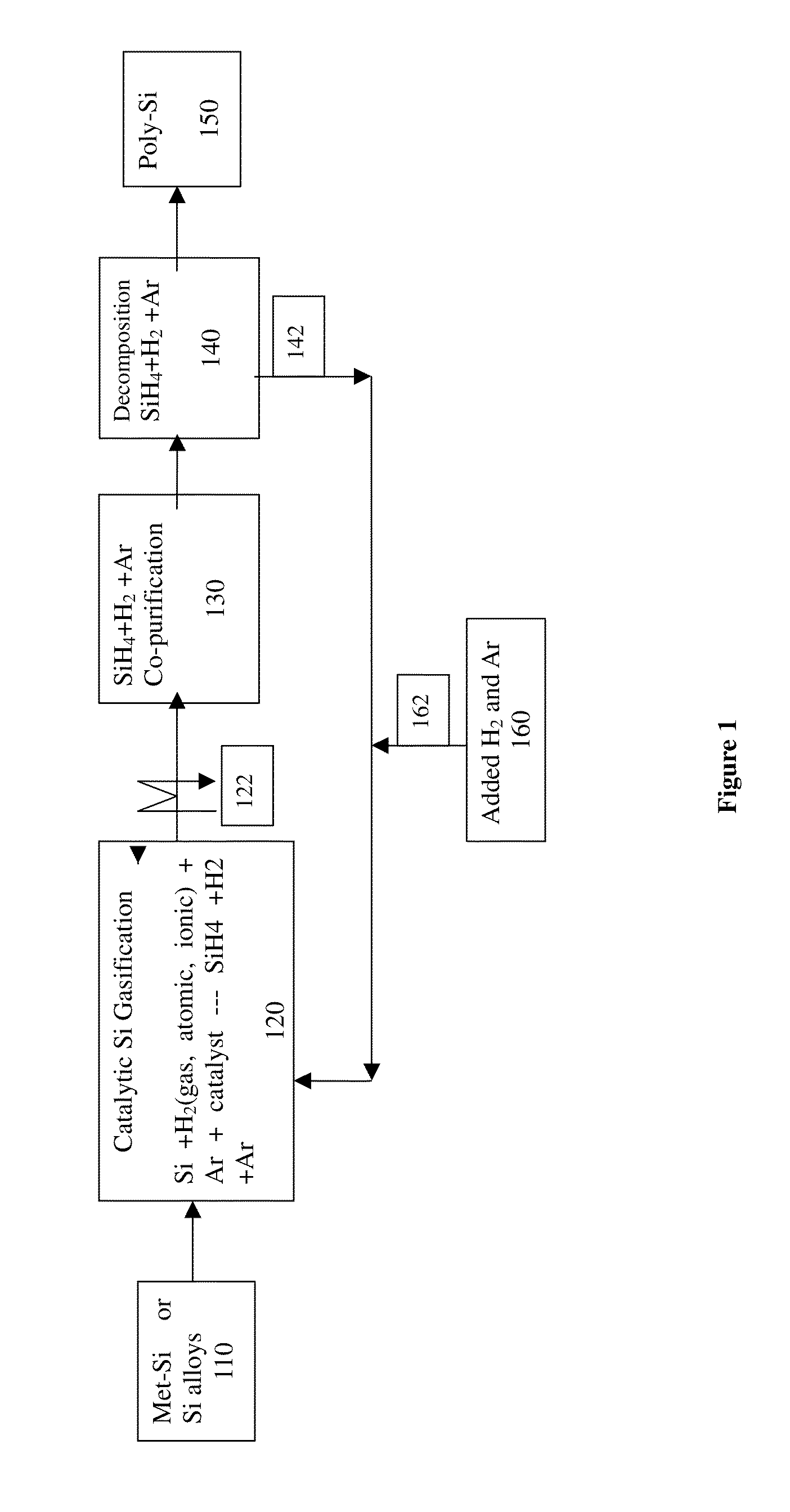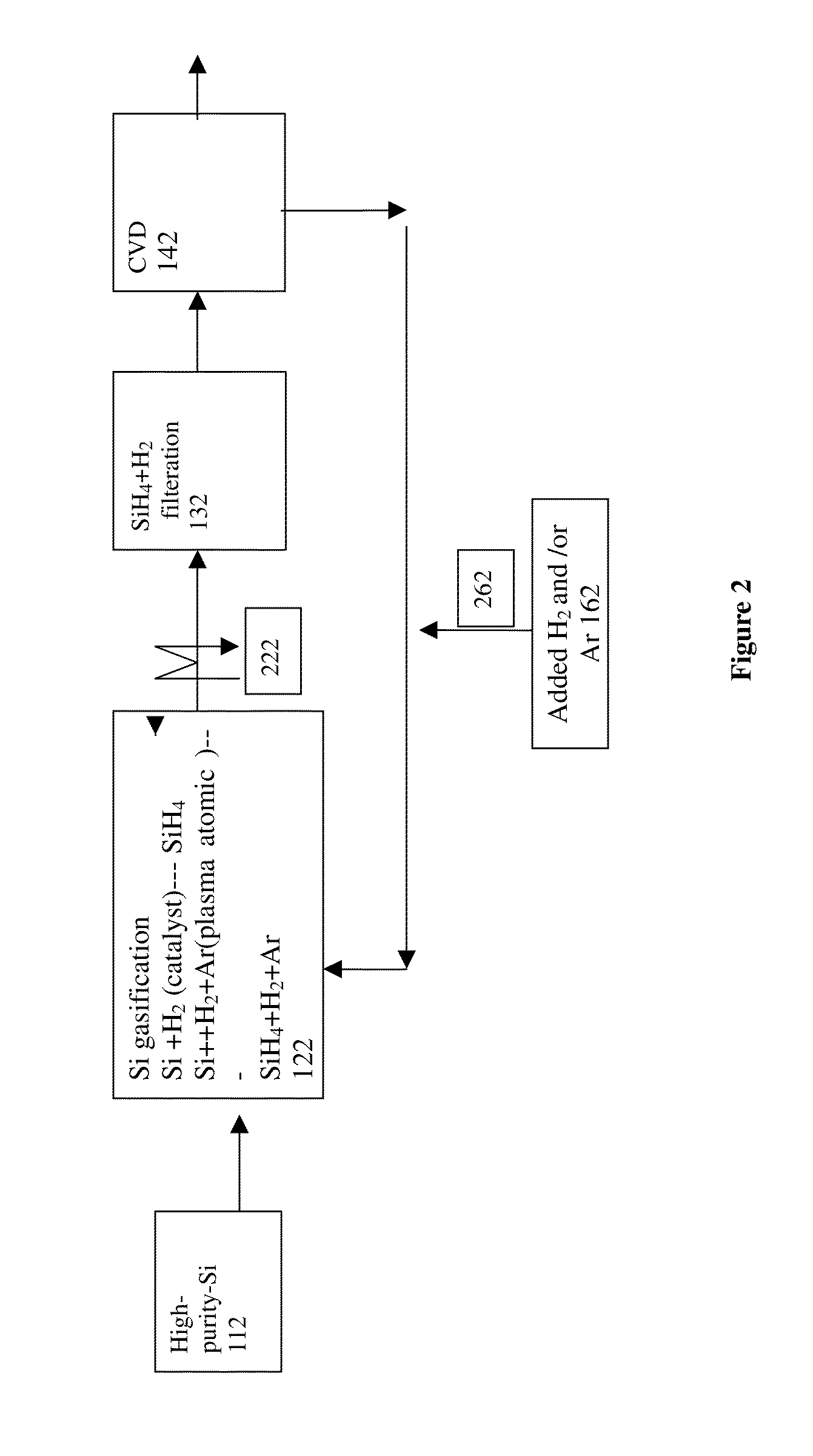Method and system for production of silicon and devicies
a production method and technology of silicon, applied in the direction of silicon compounds, lighting and heating apparatuses, furnaces, etc., can solve the problems of single successful experiment on this approach, low production yield, and unfavorable direct reaction between silicon and hydrogen, so as to reduce the cost, reduce the reaction temperature, and enhance the reaction rate of silane formation
- Summary
- Abstract
- Description
- Claims
- Application Information
AI Technical Summary
Benefits of technology
Problems solved by technology
Method used
Image
Examples
example 1
Catalytic Gasification of Metallurgical Silicon Using Hydrogen Gas
[0114]2.0 wt % Cu, and 1 wt % Ni catalyst (using chlorides) is loaded onto met-silicon powder 100-30 mesh through solution impregnation or coating. After drying, silicon powder is heated in a fluidized bed reactor, a spouted bed and a packed bed reactors respectively in flow of chemical pure hydrogen at 900-1300° C. respectively. As shown in FIG. 5b, orange color flame was observed by the burning of the tail gas from the reactor indicating the formation of silane. In addition, the weight of silicon powder is noticeably reduced after 10 hours of reaction. The tail gas from the reactor is also quenched very quickly to about 500 C. or lower, or 300 C. or lower by passing the tail gas to a heat exchanger with a circulating coolant. In comparison, same amount of metallurgical silicon without catalyst is heated under the same conditions, and no mass loss of silicon is detected.
example 2
Catalytic Hydrogen Gasification on the Surface of Single Crystal Silicon
[0115]To gain microscopic understanding of silicon gasification, a single crystal 100 wafer is chosen and divided into two pieces sample A and sample B respectively. A few droplets of palladium acetate solution (with acetone) is sprayed on the surface of sample A. After drying, the wafer was broken into small pieces and heated in hydrogen at various temperature for a series of time intervals. In each case, a small piece of sample B is used as a control sample. After the reaction, each sample was examined under a scanning electron microscope (SEM) for surface morphology.
[0116]FIG. 7 shows a SEM micrograph of a Pd catalytically etched sample A single crystal surface after heating in hydrogen at 900° C. for 30 minutes. It can be seen that Pd forms catalyst particles as indicated as 711, 712, and 716, during the gasification reaction, the particles move on the single crystal surface, meanwhile they create channels (...
example 3
[0117]Gasification of silicon by plasma generated atomic hydrogen using a commercial DC plasma torch, with hydrogen being used to form a hydrogen plasma in a fluidized bed reactor, a spouted bed and a packed bed reactors respectively generating orange color flames and golden deposit on the down stream wall indicating the formation of silane.
Example 4
[0118]Gasification of silicon by plasma generated atomic hydrogen using a commercial ICP plasma torch, with hydrogen being used to form a hydrogen plasma in a fluidized bed reactor, a spouted bed and a packed bed reactors respectively generating orange color flames and golden deposit on the down stream wall indicating the formation of silane.
PUM
| Property | Measurement | Unit |
|---|---|---|
| temperature | aaaaa | aaaaa |
| temperatures | aaaaa | aaaaa |
| temperature | aaaaa | aaaaa |
Abstract
Description
Claims
Application Information
 Login to View More
Login to View More - R&D
- Intellectual Property
- Life Sciences
- Materials
- Tech Scout
- Unparalleled Data Quality
- Higher Quality Content
- 60% Fewer Hallucinations
Browse by: Latest US Patents, China's latest patents, Technical Efficacy Thesaurus, Application Domain, Technology Topic, Popular Technical Reports.
© 2025 PatSnap. All rights reserved.Legal|Privacy policy|Modern Slavery Act Transparency Statement|Sitemap|About US| Contact US: help@patsnap.com



